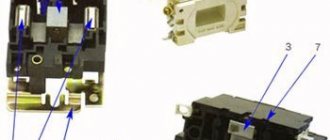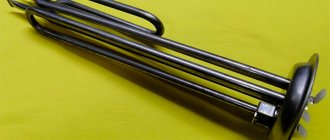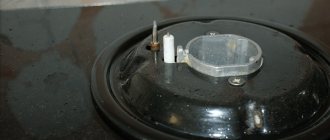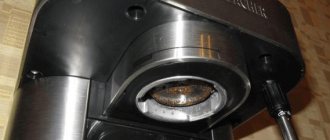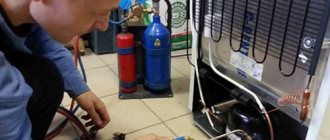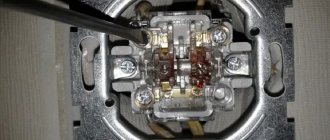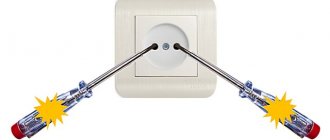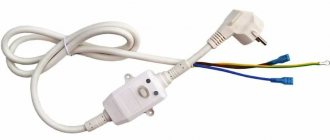The article was written with the support of specialists from the household appliance repair shop - Absolute.
This household appliance has become so familiar that if difficulties arise, panic immediately begins. But don’t worry, it’s not so difficult to deal with the main malfunctions of a non-working microwave, and also to fix the problems. You can learn how to diagnose and repair microwave ovens yourself, which will significantly save costs. Let's look at methods for solving the most popular microwave oven problems.
Do-it-yourself microwave repair
Repairing a microwave oven requires special professional knowledge and skills. But with a little knowledge of the basics of electrical and radio engineering, and knowing how to use electrical tools, you can try to cope with this problem, even if you are a builder, musician or doctor. To make repairs yourself, just remember what you were taught at school during labor lessons. In this case, you must follow electrical safety rules: do not make short circuits when connecting wires, and do not stick your fingers into the socket. If you are not confident in yourself, then it is better to contact a specialist service center.
If the Samsung machine is under warranty
If a machine that is under warranty breaks down, you should not try to repair it yourself. .
First you need to find a warranty card. It may indicate the number of the service center to contact.
If there are no contact details, you need to go to the store where the equipment was purchased. At the point of sale, the goods must be taken away for examination.
After determining the cause of the breakdown, there are 3 options for the development of events:
- The device will be repaired free of charge.
- The buyer gets his money back.
- The product is exchanged for a similar one.
As a rule, problems do not arise with equipment that has a manufacturing defect. If the store refuses to accept a broken machine, you need to write a complaint addressed to the director. When you cannot get an answer, you should contact the court or the Consumer Rights Protection Department. The maximum period for consideration of a claim is 10 days.
Delivery of the washing machine to the store is the responsibility of the buyer. The seller must transport the equipment to the examination site.
If he did not do this, and the cause of the breakdown is defective, the store is obliged to pay the costs incurred by the consumer. In this case, you need to collect all the receipts to prove your case in court.
Principle of operation
After connecting the microwave to the network, a voltage of 220V is supplied to the first winding of the transformer. Automatically the voltage is transferred to the secondary winding. The chamber heating system starts. Due to the fact that these two windings are isolated from each other, safe operation of the microwave oven is ensured. A microwave oven allows you to heat food at high speeds by using double the voltage. In this circuit, the main role is played by a capacitor, to which a diode is connected in parallel. The duration and magnitude of the temperature regime helps to control the temperature sensor and a regular timer. For safe use, the oven has a built-in power protection relay, the function of which is to stop the operation of the microwave in the event of high voltage drops in the network or when the door is open. If all this description seems complicated to you, then don’t worry: we’ll figure it out now.
Instructions for replacing the light bulb
1. Unplug the oven and wait at least 10 minutes for the capacitors to discharge. Using a screwdriver, unscrew the screws that secure the metal casing of the stove. The light bulb is located where there are holes on the inside, behind the glass door, through which the oven is illuminated while cooking.
2. Remove or unscrew the socket from the socket and take out the light bulb. You need to buy exactly the same one. While you are looking for an analogue in the retail trade, it is better to put the stove back together so that it can be used. Such a light bulb can be bought at repair shops that receive spare parts from suppliers or at the market, from sellers who sell all sorts of small items. If the light bulb is inexpensive, buy 2-3 pieces at once.
3. When the light bulb is found, disassemble the microwave again and install the light bulb in place. Don't forget to set a clock that resets when the power is turned off.
Signs of a microwave oven breakdown
Most often, external signs of a microwave oven malfunctioning are the appearance of sparks, puffs of smoke, the plate stopping from rotating, and the lack of heating of food placed in the oven. Or the microwave simply won’t turn on. In this case, it is dangerous to plug it into the network! There are three main reasons for electrical appliance failure:
- Fuses blown;
- Magnetron malfunction;
- Burnout of the mica plate.
In case of this type of breakdown, you can repair the stove if you follow the instructions strictly. First, consider the functional diagram of a microwave oven. We take the functional diagram because It makes it easier to understand the operating principle of a microwave oven, it is universal, regardless of the brand of the oven, it is simpler compared to the circuit diagram of a microwave oven.
And the location of the microwave elements can be seen in this figure:
Replacing a light bulb in a microwave: what is needed for this
Fixing this malfunction is not difficult, but it requires minimal preparation. First you will need to stock up on the following things:
- screwdriver;
- pliers;
- multimeter;
- a new light bulb (you can pick it up in a store that sells spare parts for household appliances, and, for example, on our website).
Most often, microwave ovens have lamps with an E14 base. You can find out which lamp is installed in your microwave from the instructions.
Important information!
Remember:
- Never try to replace an old light bulb with a new one if your microwave oven is not powered off! Even when turned off, almost any equipment can be dangerous, and even more so a microwave - after all, some elements tend to accumulate electricity. Therefore, be extremely careful!
- Always change the bulb from the inside after removing the vent panel. Do not attempt to replace from the interior compartment where food is heated.
Fuse blown
This is the most common cause of failure. There are two fuses in the microwave. The first F1, the so-called mains fuse, is located at the input of the 220 volt mains voltage into the microwave oven. So he can burn out. In this case, the oven stops turning on and does not react in any way when you press any buttons. First, you need to diagnose the microwave oven: remove the mounting screws from the back side and open the protective panel. Do not forget to unplug the plug from the socket before starting repair work. Then you need to forcefully discharge the filter capacitor. To do this, its terminals are closed (i.e., connected to each other) using an insulated wire. Be sure to hold the wire strictly by its insulation. After this, check for voltage on the surge protector board and check the condition of the microwave power wires. If there are no faults in this part, you should inspect the diode in the rectifier circuit of the power supply. Most often, it is this that causes the fuse to blow in this type of breakdown. The fuse in the microwave should be checked for openness visually or using an ohmmeter, if necessary, replace it with a serviceable one and analyze the causes of the blown, in order to avoid a repetition of a similar situation, paying attention to various darkening of the radio elements, which indicate a malfunction in the microwave units. The second fuse F2 is located after the high-voltage transformer in the magnetron circuit and is called high-voltage. It is “hidden” in a plastic tube-shaped case and located next to the transformer. This fuse fails due to the failure of a high-voltage diode or capacitor. It is better to replace the fuse with a new factory-made one. it is calibrated for the desired operating current. Well, it is imperative to replace the part that led to the fuse burning. Below, watch a video about how, as a last resort, you can repair a high-voltage microwave oven fuse yourself:
Features of repairing models from different manufacturers
Despite the similarity in design and operating principle, each manufacturer uses its own secrets in the manufacture of equipment.
Taking this into account, you need to take an individual approach to repairs and pay attention to the manufacturer’s brand.
Below we will consider the features for each of the options and summarize them in a table.
| Trademark | Peculiarities |
| Rolsen | Common malfunctions include a blown fuse, the inability to turn on the device, or a broken mica plate. |
| Samsung | Microwave ovens from this manufacturer are of high quality. The latches are reliable and rarely break. The main breakdowns include uneven heating, problems with plate rotation, and loss of overall functionality. In all cases, you need to check the electronics. |
| LG | The equipment of this brand is reliable and rarely breaks down. The weakest points include the capacitor and fuse. Sometimes the power supply of the control module fails. |
| Supra | Affordable and reliable technology. Most often, the fuse blows, the indicators do not light up, and the buttons do not work. The weak point is the hook latch on the door. |
| Sharpe | The most common failures are damage to the fuse, breakdown of the diode, burnout of the mica plate. |
| Bork | Domestic technology with Chinese parts. The most common malfunctions are damage to the transformer, breakdown of the temperature sensor, malfunction of the diode or fuse. |
| Elenberg | Budget brand with a 12-month warranty. Buyers complain about abrasion of the touch buttons, the inability to turn on the device, the backlight burns out, and the appearance of smoke. In most cases, the fuse blows and the hook on the door breaks. |
| Daewoo | Product from a reliable brand. In general, Daewoo microwave ovens are reliable, easy to operate, and of good quality. During operation, the capacitor may break, and in rare cases, the magnetron. Customers often complain about a blown fuse. |
| Scarlet | Budget models that are produced in China. They are simple and reliable, but sometimes the fuse burns out and the control unit fails. Damage to the pallet motor is possible, and sometimes the backlight bulb burns out. |
| Vitek | A popular brand that produces equipment with a large number of functions. Common breakdowns include damage to the hooks on the door, blown fuse, damage to the magnetron (in the most difficult cases). |
| Erisson | Budget-friendly and easy-to-use devices. Users most often complain about control panel failure, timer damage, or fuse blown. |
Magnetron malfunction
If the backlight works in the oven, the plate rotates, but the microwave does not heat the food, then most likely the cause of the malfunction is a malfunction of the magnetron. In the above diagram, the magnetron is designated as “magnetron”. A magnetron is a device that generates microwave radiation. That is why if this part fails, the oven does not heat.
The magnetron is housed in a small rectangular metal housing. First you need to clean it and then carry out a visual inspection. Next, inspect the magnetron unit itself. Namely, the integrity of the wires connecting the terminals and the housing. Often the reason the magnetron does not work is the failure of the feed-through capacitor. Below watch the video on how to repair a microwave oven magnetron with your own hands:
After this, be sure to check the microwave control unit. Again, pay attention to burnt, sooty and dirty areas. It is these parts that will need to be replaced for the microwave to continue operating.
Burnout of mica gasket
This malfunction is most often manifested by sparking inside the chamber. Burnout of the mica gasket has virtually no effect on the heating efficiency of the furnace, but further operation of the device is fraught with more serious damage. Repairing this problem is quite simple.
Mica plate
It is enough to cut a plate of a suitable size from a new mica material and install it in place of the damaged part.
Common microwave oven failures and how to detect them
If your microwave oven does not work well or does not turn on at all, you can repair it yourself by finding the cause of the malfunction. Basically, all models of microwave ovens have the same device, and therefore they break down in almost the same way.
The microwave does not heat and there is a smell of burnt insulation.
- Short circuit between the turns of the transformer. The resistance of the primary winding of a working transformer is in the range of 2.3 - 3 Ohms. If the resistance measured with a multimeter is less than 2 ohms, this means that an interturn short circuit has occurred in the winding. The resistance of the secondary high-voltage winding should be about 150 Ohms. If, after taking measurements between the device body and the high-voltage terminal, you find a significant resistance deviation or a winding break, it means the transformer is damaged.
- Breakdown of a high-voltage capacitor. The resistance of a working capacitor should not be less than 10 MOhm, and also not equal to infinity, because this indicates an open circuit.
- Failure of the high voltage diode. Everything is simple here, if during measurement the diode shows a resistance close to zero, it means it is broken.
- The magnetron burned out. A voltage of 4 kV is supplied from the high-voltage, filament winding of the transformer to the magnetron, therefore, if the insulation is broken, breakdown easily occurs from the wave emitter to the housing. In this case, the magnetron cap often melts.
The microwave oven does not turn on and the program cannot be set.
- The power socket is faulty. First, make sure there is voltage at the outlet. Connect the appliance to a different outlet.
- The fuse has blown. If the mains voltage is connected, but the stove does not turn on, most likely one of the two fuses has blown. The first fuse is a fuse and is installed in the power supply circuit from the mains voltage. The second fuse is a temperature sensor, which is located on the surface of the heating chamber.
- The micro switch is broken. When the small limit switch is broken, then its open contacts do not signal the electronic control module to close the door, and the oven does not turn on.
- The control module or board is faulty. A conclusion about the failure of the control module can be made only after the following have been checked: fuses, micro-switch, furnace transformer. But if individual buttons on the control module did not work before, then it is probably broken.
The microwave oven sparks inside.
- The magnetron cover is burnt out. The mica plate located inside the heating chamber on the right side is often carburized. This occurs when the surface of the emitter cover, contaminated with splashes of grease, begins to burn during operation of the oven.
- Damage to enamel. Do not try to restore the insulating coating inside the heating chamber with ordinary paints or putties, as the fumes from these non-specialized products will poison the food.
- Broken door latch. Replace the broken latch as quickly as possible, because when the door is not tightly closed, microwaves come out of the inner chamber and irradiate everyone who is near the microwave oven.
The microwave oven does not stop after the timer ends.
- Relay is faulty. This intermediate relay connects voltage to the primary winding of the transformer. The cause of the relay malfunction may be its mechanical failure, or burnt contacts.
- The control module or board is faulty. You need to check the control module with keys, and it is better to replace it.
The tray does not rotate in the microwave oven.
- Malfunction of the plate rotation drive. If one tooth breaks off on a plastic gear, you can replace it with a metal insert. But if the gear is worn evenly, it will have to be replaced.
- The drive motor has failed. A restored broken engine will still not work for long after repair, so it is better to buy a new one.
The microwave oven is overheating.
- Wrong choice of location for installing the stove. Do not install the microwave oven close to other heating devices or in direct sunlight, otherwise it will quickly overheat during operation.
- Fan failure. This device can break down both mechanically and electrically. In any case, you will have to disassemble the fan, and if necessary, replace its blades, motor bearings, or the entire electric motor.
The grill does not work in the microwave oven.
- The heating element has burned out. It is very easy to check a tubular electric heater: if, when measured with a multimeter, the resistance at the contacts is equal to infinity, then the heating element is unusable.
The lighting lamp does not light.
- The lamp has burned out. If the backlight does not work, check the incandescent lamp first.
- The backlight switching circuit is broken. After replacing the lamp, the backlight still does not work - this means there is no contact with the power circuit of the lighting lamp.
The furnace sparks
This cause occurs in microwave ovens that have a mica plate covering the magnetron. Why does a microwave oven spark and crackle? Before you carry out repairs yourself, you need to know the reasons:
- Overheating of the mica plate, which is caused by drops of fat falling on it. We should not turn a blind eye to this problem. It can lead to burnout of an expensive magnetron.
- Damage to the enamel in the chamber. Occurs due to irregular cleaning of the walls, fat or food particles accumulate. These contaminants cause sparks to occur.
- Check if there are any metal products inside the stove. A coated plate or spoon and fork may cause sparks.
To eliminate the first malfunction, you need to replace the old plate with a new one. You can order the necessary material in the online store, on one of the sites you trust. The dimensions of the mica will not coincide with the inside of the microwave oven, they will be slightly larger.
Further actions:
- remove the failed plate using a tool, as it is secured with plastic latches or self-tapping screws,
- place an old piece of mica on the purchased material, cut the part strictly to size,
- install a new plate,
- Check the oven for functionality by placing a glass of water in it.
Important! It is recommended to turn on the microwave oven only with food inside. Otherwise, the device may break down over time.
You cannot turn on an empty microwave oven, as this will lead to its rapid failure.
Microwaves, not encountering any obstacles in their path, move on, being reflected on the walls of the chamber. The device will not turn off until the timer goes off, and the concentrated energy will negatively affect the microwave parts.
To cut the plate correctly you need to:
- Use a sharp knife and a metal ruler.
- Make holes for fasteners using a drill or a special punch.
- Sand the sharp ends of the plate with sandpaper (fine-grained).
- Eliminate all contaminated areas that were discovered when removing the old mica plate.
- Install the new part into place.
To eliminate the second problem - damage to the enamel, you should purchase a special product and apply it to the internal walls of the microwave oven (organosilicon paint). It will not release harmful substances into food and is resistant to temperature changes. It is prohibited to use non-specialized substances that not only lead to damage to the device itself, but also harm human health.
If the sparks were caused by the presence of metal products inside the stove, then they simply need to be removed to eliminate the problem.
Common microwave oven malfunctions and their causes
We have long been accustomed to heating and defrosting food in the microwave. The microwave oven has long and firmly entered our everyday life and won its place there. And when suddenly this useful device fails, it greatly upsets us. If you have some knowledge in the field of electromechanics and radio engineering, then in the event of a minor breakdown, you can try to repair the microwave oven yourself. But if a significant malfunction occurs or your knowledge is insufficient, it is better to use the services of a professional technician.
Where to begin?
Before replacing a light bulb, of course, you need to decide which lamp base is inside. Several types of lamps are used for lighting, and the base may differ even from the same manufacturer. To do this you need to disassemble the oven. If it is under warranty, then you cannot disassemble it yourself and you will lose the warranty.
You need to call a specialist from the warranty department, who should come and change it completely free of charge, with a mark on the warranty card and restoration of the seal. Or, take the stove yourself to a repair shop, which is the official representative for carrying out repair and service work for the brand of your stove. This point is determined by the terms of the warranty. But in the vast majority of cases, you must ensure that the device is delivered to the repair shop yourself.
If the microwave oven is out of warranty, you can safely open it, but if not, then it’s better to waste your time and take the oven for service: what if another breakdown awaits you? To replace the lamp, use our step-by-step replacement instructions.
Before you begin, check that you have the necessary tools and equipment.
:
- It is advisable to have an instruction manual for your particular microwave oven;
- a screwdriver, usually a Phillips-head screwdriver;
- It is advisable to have dielectric gloves
Why do microwave ovens break down?
It is believed that a microwave oven is a fairly reliable unit that rarely fails. And most often, the reasons for its breakdown are improper operation and wear of parts during long-term use of the device. So why might a microwave break?
- When heating, utensils that are not suitable for microwave use are used. Only glass or plastic containers can be used in the SChV. The container lid must be open. When heating with a tightly closed lid, the cookware may explode, which will damage the inner chamber and parts of the stove.
- There is a metal object in the microwave while it is running. Often, users leave cutlery in dishes, which can lead to sparking, cracking and puncture on the inner surface of the chamber. The same consequences will result from using metal utensils or utensils with foil patterns applied to them.
- When heating food, a special plastic cap is not used. It protects the chamber walls and internal elements from contamination by drops of liquid and fat that evaporate from the surface of the dish when heated.
The plate does not rotate
If the microwave oven starts, but the plate does not rotate, then there may be several reasons for such a breakdown. If the pallet does not rotate, you should first check the following parts:
- Reducer gears
- Drive motor
- Wire contacts
- Correct installation of the plate
The most common cause of no rotation is a faulty motor. The winding of this part can burn out if there are significant voltage surges or if it gets wet while washing the inner surface of the metal chamber. Replacing the motor with a known good part will completely restore the rotation of the plate.
Gearbox malfunction can be caused by severe wear of the gears, which can jam during rotation, and at a later stage of wear, the plate may not rotate due to lack of contact between the teeth. The rotation of the plate can be restored if the gearbox is faulty only by replacing the drive assembly with the electric motor.
Electric motor with gearbox
If the plate does not rotate due to poor contact of the electrical wires with the electric motor, then it is enough to press the contacts with pliers to restore the functionality of the electrical unit.
Diagnosing microwave malfunctions
You can determine whether a microwave oven is truly hollow using the method of elimination. To do this, inspect the unit and check the functioning of the following elements:
- You need to start by checking the integrity of the power cord and outlet. If there is a break in the cord or an overloaded outlet, the microwave will not work. Here you should pay attention that the microwave oven is sensitive to the mains voltage. If the voltage is lower than 220 volts, the device does not work.
- The next step is to check the tightness of the door closure. Microwaves are dangerous to human health. And therefore the oven is designed in such a way that it can operate with the door tightly closed. If the lock on the door, the locking system or the closing element is broken, the microwave will not turn on.
- The last step is to check the fuse and thermal relay. The mains fuse may blow due to a sudden voltage drop in the network or a short circuit. If you replace the fuse, the device will work properly. The thermal relay turns off the operation of the device when the door is open. If the thermostat is not working properly, it needs to be replaced.
Device and principle of operation
We will look at this issue superficially so as not to deviate from the main topic. The information will be simplified as much as possible, since not all home craftsmen have deep knowledge of electrical engineering. Let's start with a description and purpose of the main structural elements, they are presented below in the figure.
Designations:
- Door latches serve both to secure the door and to lock the door in the open position.
- A rotating tray on which dielectric cookware is placed.
- A separator equipped with rollers that drives the pallet.
- Drive rotating the separator.
- The backlight turns on depending on the operating mode.
- Ventilation (usually forced).
- A magnetron is a microwave radiation generator; in fact, it is the main structural element. You can find out how it works and the principle of its operation by reading the article on our website dedicated to this issue.
- The waveguide ensures the movement of microwave waves to the microwave chamber. It is a hollow metal pipe of rectangular cross-section.
- High voltage diode.
- Capacitor.
- Waveguide power supply circuit transformer and control circuit.
- Control block.
We will not provide a complete schematic diagram of the device, since they can differ greatly in different models of microwave ovens. In our case, the magnetron power circuit will be sufficient. As a rule, it has a standard structure.
Let us briefly describe the operating principle of the above circuit. Power to the primary winding of the transformer (I) comes from an external control circuit that regulates the power and duration of microwave radiation. One of the secondary windings (II) supplies voltage to the magnetron filament. Winding II is made of 2-4 turns of thick wire, since the current in the filament circuit can reach 10.0 A at a voltage of about 3 volts.
Another secondary winding (III), which supplies a high voltage level (up to 3.0 kV), is usually called anode. As can be seen from the figure, in this circuit, a rectifier and voltage multiplier are built on the basis of a high-voltage diode (VD1) and a capacitor (C1). In this case, VD1 is turned on so that the opening occurs at a positive half-cycle, as a result the capacitor begins to charge. When the negative half-cycle begins, diode VD1 closes and voltage is supplied to magnetron M1 together with the charge accumulated on the capacitor. This leads to a doubling of the voltage and the formation of an electric field of the required intensity in the magnetron.
Resistance R1 in this case is necessary for discharge C1. Typically, this resistor is located in the capacitor housing. As for VD2, it provides protection in the event of an increase in voltage across capacitor C1 or a short circuit occurs in magnetron M1.
Basic malfunctions of microwave ovens
Microwave won't turn on
There may be several reasons why the microwave oven does not turn on:
- The power cord is faulty. It may be broken or the wire contacts have come loose from the control board. The malfunction can be eliminated by soldering the contacts, and if the problem is in the cord, by replacing it.
- The high voltage fuse has blown. It needs to be replaced.
- The door lock microswitch is broken. It needs to be replaced or the contacts restored.
- The thermostat is not working. Here you need to figure out whether the thermostat has burned out and needs to be replaced, or there is a malfunction in the cooling system of the furnace chamber. A competent technician will be able to figure out the problem.
- The control board has failed. Frequent causes of this malfunction are voltage surges. The step-down transformer on the board most often fails, and various radio elements of the supply circuit break less often.
The plate doesn't spin
The plate rotates poorly or does not rotate at all due to a malfunction of the motor that rotates the tray. Most often, the engine breaks down due to drops of water, grease and food particles adhering to the shaft. This leads to difficulty in rotating the shaft, increasing the load on the coil and causing it to burn out. If rotation difficulties arise, the shaft can be carefully cleaned of dirt. If the coil burns out, it needs to be replaced.
Another reason may be a violation of the integrity of the electrical circuit.
Microwave doesn't heat
- The fuse has blown. It needs to be replaced.
- Magnetron failure. The causes of such breakdowns can be voltage surges in the network, short circuit, capacitor malfunction, as well as element wear. A qualified technician can deal with the causes of magnetron malfunction.
- The network voltage is below 220V.
Sparking and crackling in the microwave chamber
Such signs indicate that the mica platinum has burned out. The reason for this is heating food in an open container. This causes liquid and fat to evaporate from the surface of the dish and settle on the plate. Also, mica can burn out if there is any metal object, even a small one, in the chamber. Or excessive wetting of the plate during cleaning.
The microwave oven makes a loud noise
If operated for a long time at maximum mode, the magnetron may fail. A short circuit may also occur in one of the windings of the high-voltage transformer, which also leads to increased sound. Fan malfunction also results in increased sound and noise.
Touchpad buttons don't work
During operation, the contacts on the buttons are broken. They require restoration, or a complete replacement of the button or touch panel. Also, the lack of response to pressing a button may indicate a malfunction of the control unit.
The light in the oven chamber does not light up
The chamber light turns on when the door is opened and while the microwave is operating. The absence of backlight indicates that the light bulb has exhausted its life and has burned out. It needs to be replaced. Less often, the light bulb does not light up due to wiring faults.
These and many other microwave malfunctions can be easily fixed by a technician from. We have been working with all brands of microwave ovens for more than 15 years and will be happy to come to your aid in any situation. You can call a specialist today by phone or using a special form on the website.
Checking the locking system
Regardless of the microwave oven model, there is a magnetron inside, which is a radio-emitting device. If precautions are not taken, radiation can cause enormous harm to human health. The door with transparent glass and metal mesh prevents radiation from penetrating outside. It is tightly connected to the body; it is in this place that the electromagnetic wave has zero value.
It is very important to regularly diagnose the locking system:
- First, inspect the door to determine the tightness of the seal and the security of the lock. You can use a sheet of paper for this.
- Place it between the doors and the body, press it, and try to remove it from the chamber.
- If effort is made to remove the paper, then everything is in order. If the sheet comes out freely, it indicates that the door needs to be adjusted.
- Settings are made in two places: the hinge area and the lock area. The main goal is to tightly fit the door to the base so that the radiation does not spread beyond the boundaries of the household appliance.
- Particular attention should be paid to the microswitch, both in the open and closed states. Test them using a tester and if problems are found, replace both, since they have the same service life.
To reduce the gap you need to:
- loosen the screws securing the door hinges,
- press the upper part of the sash so that the seal fits tightly to the oven chamber,
- tighten the door hinge screws.
Attention! The microwave will not turn on unless a signal is sent to the electronic control module that the door is closed. In this case, the contacts are open, which means the limit switch is broken. It should be replaced.
Common microwave oven malfunctions and their causes
We have long been accustomed to heating and defrosting food in the microwave. The microwave oven has long and firmly entered our everyday life and won its place there. And when suddenly this useful device fails, it greatly upsets us. If you have some knowledge in the field of electromechanics and radio engineering, then in the event of a minor breakdown, you can try to repair the microwave oven yourself. But if a significant malfunction occurs or your knowledge is insufficient, it is better to use the services of a professional technician.
Choosing a replacement light bulb
When starting a search, first of all, clarify all its parameters:
- power;
- ability to withstand high temperatures;
- the presence of an incandescent filament (in branded microwaves, they usually do not have a spiral, although older models may have different ones);
- base diameter.
There are universal lamps for all types of microwave ovens. However, equipment manufacturers insist that you need to select one that matches the brand of the device manufacturer. For example, buy a similar one for an LG microwave oven. This guarantees the compatibility of the part with the unit and its long service life.
Please also note: parts of even the same brand in different models are not the same in power and size.
In general, light bulbs with an E-14 base and a power of 20 watts are usually used. But some do not have threads. They are not unscrewed, but replaced along with the base using special contacts. These are sold in specialized stores.
Why do microwave ovens break down?
It is believed that a microwave oven is a fairly reliable unit that rarely fails. And most often, the reasons for its breakdown are improper operation and wear of parts during long-term use of the device. So why might a microwave break?
- When heating, utensils that are not suitable for microwave use are used. Only glass or plastic containers can be used in the SChV. The container lid must be open. When heating with a tightly closed lid, the cookware may explode, which will damage the inner chamber and parts of the stove.
- There is a metal object in the microwave while it is running. Often, users leave cutlery in dishes, which can lead to sparking, cracking and puncture on the inner surface of the chamber. The same consequences will result from using metal utensils or utensils with foil patterns applied to them.
- When heating food, a special plastic cap is not used. It protects the chamber walls and internal elements from contamination by drops of liquid and fat that evaporate from the surface of the dish when heated.
Causes of breakdowns
In most cases, the cause of microwave oven breakdowns is non-compliance with operating instructions. The first rule to remember is that no metal objects should get into the camera. Even a metallic rim on a plate - painted with paint that contains metal - can cause violent sparking in the microwave. The spark often “pierces” the magnetron, which then fails. In addition, it is when the microwave sparks that the protective plate is damaged and the elements of the power circuit may fail.
The second common reason is the use of cookware that is not intended for microwave ovens. If you heat food in a regular closed container, it may burst. In this case, the contents scatter in all directions, clog the waveguide, and the microwave does not work again. Turning it on in this state will again lead to burnout of the magnetron.
Using utensils that are not intended for microwave ovens may cause damage.
The last unacceptable mode is no load. If you turn on a microwave with an empty chamber, it is almost guaranteed to fail. And in this case the magnetron will also burn out.
There are not many technical reasons for the breakdown of microwave ovens. Firstly, these are changes in nutrition. This problem can be eliminated by installing a voltage stabilizer. Secondly, this is the physical wear of parts. This is true for equipment that has been in operation for more than 7 years. Thirdly, the use of low-quality parts. This is the problem with cheap technology. And fourthly, a manufacturing defect. And again, brands that have been on the market for many years have better quality control than brands that are unknown to anyone. The good news is that manufacturing defects usually work out during the warranty period.
Diagnosing microwave malfunctions
You can determine whether a microwave oven is truly hollow using the method of elimination. To do this, inspect the unit and check the functioning of the following elements:
- You need to start by checking the integrity of the power cord and outlet. If there is a break in the cord or an overloaded outlet, the microwave will not work. Here you should pay attention that the microwave oven is sensitive to the mains voltage. If the voltage is lower than 220 volts, the device does not work.
- The next step is to check the tightness of the door closure. Microwaves are dangerous to human health. And therefore the oven is designed in such a way that it can operate with the door tightly closed. If the lock on the door, the locking system or the closing element is broken, the microwave will not turn on.
- The last step is to check the fuse and thermal relay. The mains fuse may blow due to a sudden voltage drop in the network or a short circuit. If you replace the fuse, the device will work properly. The thermal relay turns off the operation of the device when the door is open. If the thermostat is not working properly, it needs to be replaced.
Advantages and disadvantages
The presence of a grill built into the microwave oven significantly expands the capabilities of this electrical appliance. With its help, you can always get a lot of different dishes in a short period of time: golden brown chicken, vegetables that taste like they were cooked over a fire, fish and even baked goods.
Using a grill, meat and fish will never be fatty, because they do not need to use a large amount of vegetable oil. Accordingly, the food turns out tasty and at the same time healthy.
Using the analyzed function is very simple. The main thing is to follow the manufacturer’s clear instructions.
As for the shortcomings, there are three of them:
- The microwave becomes very dirty after the cooking process is completed. However, if you wipe off all the dirt at once, you won’t have to struggle with cleaning for a long time.
- According to some reviews, food after such a grill is not very tasty, because it does not have the smell of smoke and the specific taste that always exists after a fire.
- When drops of fat fall on the heating elements, an unpleasant odor occurs inside the device.
All of the above disadvantages can be easily avoided if you take proper care of your microwave oven on time and properly.
Basic malfunctions of microwave ovens
Microwave won't turn on
There may be several reasons why the microwave oven does not turn on:
- The power cord is faulty. It may be broken or the wire contacts have come loose from the control board. The malfunction can be eliminated by soldering the contacts, and if the problem is in the cord, by replacing it.
- The high voltage fuse has blown. It needs to be replaced.
- The door lock microswitch is broken. It needs to be replaced or the contacts restored.
- The thermostat is not working. Here you need to figure out whether the thermostat has burned out and needs to be replaced, or there is a malfunction in the cooling system of the furnace chamber. A competent technician will be able to figure out the problem.
- The control board has failed. Frequent causes of this malfunction are voltage surges. The step-down transformer on the board most often fails, and various radio elements of the supply circuit break less often.
The plate doesn't spin
The plate rotates poorly or does not rotate at all due to a malfunction of the motor that rotates the tray. Most often, the engine breaks down due to drops of water, grease and food particles adhering to the shaft. This leads to difficulty in rotating the shaft, increasing the load on the coil and causing it to burn out. If rotation difficulties arise, the shaft can be carefully cleaned of dirt. If the coil burns out, it needs to be replaced.
Another reason may be a violation of the integrity of the electrical circuit.
Microwave doesn't heat
- The fuse has blown. It needs to be replaced.
- Magnetron failure. The causes of such breakdowns can be voltage surges in the network, short circuit, capacitor malfunction, as well as element wear. A qualified technician can deal with the causes of magnetron malfunction.
- The network voltage is below 220V.
Sparking and crackling in the microwave chamber
Such signs indicate that the mica platinum has burned out. The reason for this is heating food in an open container. This causes liquid and fat to evaporate from the surface of the dish and settle on the plate. Also, mica can burn out if there is any metal object, even a small one, in the chamber. Or excessive wetting of the plate during cleaning.
The microwave oven makes a loud noise
If operated for a long time at maximum mode, the magnetron may fail. A short circuit may also occur in one of the windings of the high-voltage transformer, which also leads to increased sound. Fan malfunction also results in increased sound and noise.
Touchpad buttons don't work
During operation, the contacts on the buttons are broken. They require restoration, or a complete replacement of the button or touch panel. Also, the lack of response to pressing a button may indicate a malfunction of the control unit.
The light in the oven chamber does not light up
The chamber light turns on when the door is opened and while the microwave is operating. The absence of backlight indicates that the light bulb has exhausted its life and has burned out. It needs to be replaced. Less often, the light bulb does not light up due to wiring faults.
These and many other microwave malfunctions can be easily fixed by a technician from. We have been working with all brands of microwave ovens for more than 15 years and will be happy to come to your aid in any situation. You can call a specialist today by phone or using a special form on the website.
How to change a light bulb in a microwave
To restore the lighting, you will have to remove the upper part of the microwave oven body, the so-called “casing”. Therefore, arm yourself with a Phillips screwdriver or screwdriver. Wear dielectric gloves, as some parts of the device can accumulate an electrical charge.
Step by step replacement:
- Disconnect the device from the network.
- Unscrew the screws holding the casing on the back and sides. The number of fasteners may vary depending on the model.
- Detach the top. It resembles the letter "P". You may have to push or pull it a little so that the walls come out of the grooves.
- The light bulb is on the same side as the control panel. To replace it, remove the terminal, unscrew the light bulb from the socket, and screw in a new one.
- You may have to unscrew the metal strip or corner into which the lamp is inserted to get to the lighting. Carefully bend the edges of the fasteners with pliers.
We select a worthy replacement
In microwave ovens, lamps of 20 Watt, 25 Watt, with E14 base are used. But, alas, things are not always so simple. In some models (for example, LG brand) the glass bulb does not unscrew from the socket. Therefore, remove the entire set, disconnecting the contacts, and go to the market or online store for a new one.
When choosing a replacement, remember to ensure maximum compatibility of parts. For the Samsung brand, it is better to take Samsung spare parts, while Panasonic is suitable for Panasonic. The required parameters are indicated on the technical specifications plate, in the instructions, and sometimes on the cartridge itself. A correctly selected part for a microwave oven will last longer. A special heat-resistant light bulb with a socket costs about 300 rubles. But if you want to save money, you can clean the socket and adapt it to a regular light bulb with suitable parameters, as the young master did in the video:
This option will cost three times cheaper.
Checking interior lighting
So, you have replaced the lamp, now you need to check if the light is on. Don't rush to turn on the microwave. First you need to assemble it. Never operate the oven without the cover: you and your loved ones may be harmed by microwaves. Remember about safety precautions! If the new light blinks and gradually goes out, look for a problem in the wiring or contacts. If there is chaotic blinking, the reason is most likely a disruption in the conductivity of the current in the base.
Now you know how to replace the lamp if the light in the MVP does not light. We hope you can do this yourself. Good luck!
The microwave has become an indispensable tool in the kitchen and offices. It allows you to save time when heating ready meals and defrosting semi-finished products. We are so accustomed to the existence of a microwave oven that we immediately begin to panic if any difficulties arise in its operation. Let's try to figure out what malfunctions can occur in a working microwave, and what ways to solve this problem exist.
Before trying to find the problem yourself, you should study the device and understand how it works. The microwave consists of: a chamber, a door with a seal, a magnetron responsible for generating energy, an energy converter - a transformer, a diode, a capacitor, and a fan. Auxiliary elements of the microwave are grill and tray lamps, fan and tray motors.
Food in a microwave oven is heated by high-power electromagnetic radiation.
A magnetron is a diode that generates electromagnetic waves when a flow of electrons interacts with a magnetic field. In the center of the cylindrical copper anode there is a rod cathode with a channel filament, which releases electrons. The standard power output from the magnetron is 800 watts
.
Due to the fact that the magnetron generates a lot of heat during operation, its housing must be placed in a plate radiator, constantly blown by air coming from a fan. Also, for protection reasons, the magnetron is equipped with a special thermal fuse to prevent overheating.
Another important component of any microwave is the fan
. The fan creates airflow over the magnetron, the grill, and the chamber itself, from which, thanks to the action of this device, air and water vapor come out. With the help of air ducts located inside the furnace, the air received by the fan from the outside circulates.
Any oven has a shielded chamber
, protected by a metal casing that prevents radiation from penetrating outside. The metal mesh on the glass of the microwave door is also not accidental - it does not allow rays of 2450 Hz to pass through. The door itself must fit very clearly to the body; it is important to exclude any even slightest distortion. In the naturally formed gap, which maintains its geometric shape, a so-called standing wave of electromagnetic pulses is formed; it takes on a value equal to 0, precisely here, and this prevents the penetration of radiation beyond its limits.
The control unit is designed to maintain the set power and turn off the device after the set time has elapsed. These are the two main functional parameters. In modern models, however, the functionality of the unit has expanded significantly, and now microwave ovens may have a built-in clock, a power indicator, standard cooking or defrosting programs, an end-of-work signal and some other functions.
Review of the best representatives
The rules for using the grill in each microwave may differ from each other. The most popular options for these electrical appliances are these models.
Samsung MC28H5013AK
Feature: allows you to make cheese and yogurt.
- modern design;
- low cost;
- the presence of a bioceramic coating makes it possible to quickly and easily clean it from dirt;
- there are 24 cooking programs for various types of dishes;
- cooks and heats food quickly and always evenly;
- The glass tray moves smoothly, without jerking.
The downside is that the function buttons are not backlit. For people with poor vision, this causes significant inconvenience when using the device.
Midea AW925EHU
Feature - can cook dried fruits.
- there is a built-in self-cleaning function;
- availability of 10 programs for cooking;
- not too high cost;
- large volume;
- heating element grill.
Disadvantages - the device is difficult to control, so it will be difficult to work with it at first without instructions.
Panasonic NN-CD565BZPE
Feature: Thanks to inverter control, it perfectly heats small portions of food.
- good capacity;
- the presence of a quartz grill;
- 24 programs make it possible to prepare a variety of dishes;
- There is a self-cleaning mode.
- high price;
- If the temperature is incorrectly selected, the top of the dough may burn during baking.
Grilling in the microwave is a great solution for preparing many delicious dishes. At the same time, the food does not become saturated with fat and does not burn, remaining useful for children and adults. You can get fried meat, fish or crispy pizza in a short time, while saving energy and effort.
One of the world's leading brands in the production of household appliances, Samsung, has pleased its consumers with the breadth of its model range and types of microwave ovens. Among all the variety you can find the following devices:
- convection microwave ovens;
- devices with grill;
- premium series microwaves;
- simple household appliances of the "economy" class.
